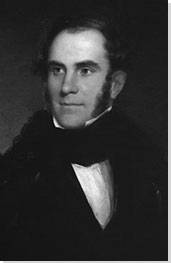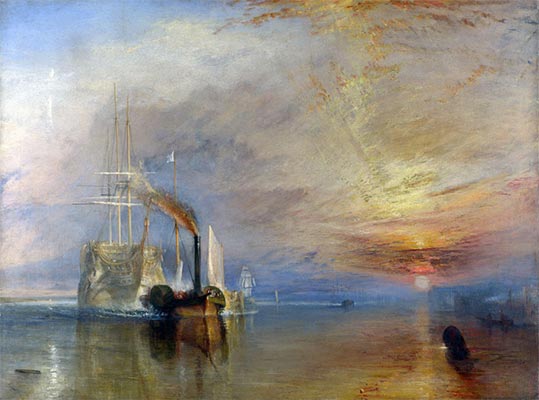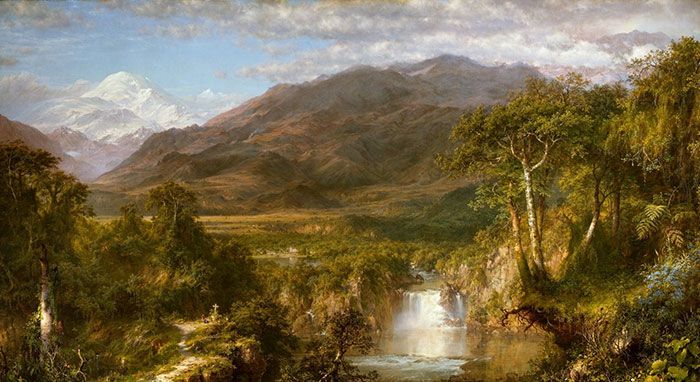Summary of Thomas Cole
The paintings of Thomas Cole, like the writings of his contemporary Ralph Waldo Emerson, stand as monuments to the dreams and anxieties of the fledgling American nation during the mid-19th century; and they are also euphoric celebrations of its natural landscapes. Born in the industrial north-west of England, Cole moved to the United States as a young man, and from that point onwards sought to capture in paint the sublime beauty of the American wilderness. He is considered the first artist to bring the eye of a European Romantic landscape painter to those environments, but also a figure whose idealism and religious sensibilities expressed a uniquely American spirit. Indeed, despite his upbringing in Britain - or perhaps because that upbringing gave him a fresh perspective - his work continues to resonate as an exemplar of that spirit in the modern day.
Accomplishments
- No one before Thomas Cole had applied the motifs and techniques of European Romantic landscape painting to the scenery of North America. In his works, we find the dramatic splendor of Caspar David Freidrich or J.M.W Turner transposed onto the Catskill and Adirondack Mountains. But whereas younger American painters such as Albert Bierstadt had come into direct contact with The Düsseldorf School of painting, and thus with the tradition in which they placed themselves, Cole was largely self-tutored, representing something of the archetypal American figure of the auto-didact.
- Thomas Cole is seen as the founding father of the Hudson River School, a group of American artists who sought to depict the untainted majesty of the American landscape, particularly that located around the Hudson River Valley in New York State. Cole was the first to explore this territory, taking steamboat trips up the valley from the mid-1820s onwards, and his work became a touchstone for a whole generation of American artists including Frederic Edwin Church, Albert Bierstadt, and Asher Brown Durand.
- In many ways, Cole's art epitomizes all contradictions of European settler culture in America. He was in love with the sublime wildness of the American landscape, and sought to preserve it with his art, but his very presence in that landscape, and the development of his career, depended on the processes of urbanization and civilization which threatened it. From a modern perspective, Cole's Eurocentric gaze on seemingly empty wildernesses which had, in fact, been populated for centuries, also seems troubling; where Native Americans do appear in his work, as in Falls of the Kaaterskill (1826), it is as picturesque flecks rather than characterized participants in the scene.
- Cole's paintings often serve as warnings about the destructive course of human civilization, offering portents of the devastation of the natural world, and the ceaseless spread of industry, which the American project seemed to represent. A deeply religious man, Cole saw these processes as transgressing God's will in some way, and various of his works imply that a moment of judgement or catastrophe might be imminent.
Important Art by Thomas Cole
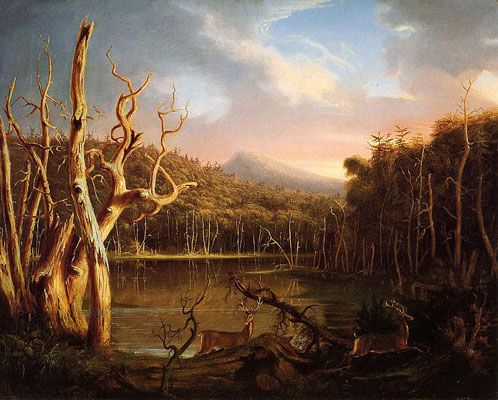
Lake with Dead Trees (Catskill)
Lake with Dead Trees is one of Cole's earliest works depicting the landscapes of the Catskill Mountains in south-east New York State. At the edge of a motionless lake, surrounded by dead trees, two deer are roused into action: one is poised and alert, the other leaps skittishly off to the right. Behind the dark wooded peaks sunlight streams through a cloudy sky.
Interpreted as a meditation on the nature of life, death, and the passage of time, this was one of five paintings exhibited in New York City in November 1825 on Cole's return from his first major trip along the Hudson Valley. Their acclaim amongst his contemporaries helped to ground his reputation as a painter of the American wilds; the writer William Dunlap purchased this piece, and published several articles praising Cole's self-taught painting techniques. Cole's career was advanced further around this time when he met the Baltimore collector Robert Gilmor Jr., who would become an important patron to the artist.
In terms of Cole's development as a painter, this image of untamed nature marks the start of his engagement with the Hudson River Valley as a source of inspiration. He once observed that "the most distinctive, and perhaps the most impressive, characteristic of American scenery is its wilderness", and, for the first time in North-American art, Cole brought the impulses of a European Romantic landscape painter to bear on that wilderness: compare this painting to the work of Caspar David Friedrich, for example. Indeed, of all the Hudson River School artists, Cole was the most interested in conveying the Northern-European Romantic concept of the Sublime, whereby the viewer loses themself in the perception of a landscape whose scale and beauty are both inspiring and fearful.
Oil on canvas - Allen Art Museum, Oberlin College, Ohio
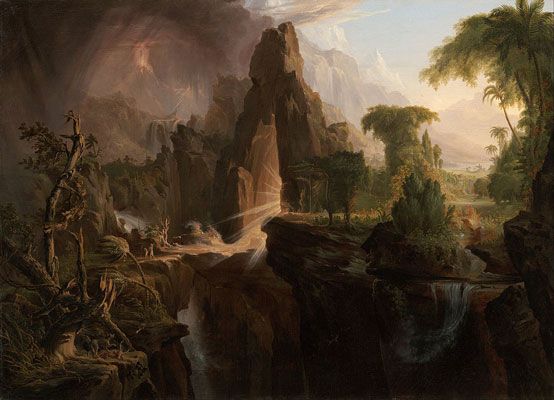
Expulsion from the Garden of Eden
This painting depicts the moment in the Book of Genesis when God expels Adam and Eve from the Garden of Eden. Rather than focusing on the naked humanity of the couple, however, Cole dwarfs them within a natural setting whose scale and majesty symbolize heavenly power. Counterintuitively, the painting should be read from right to left, since the Garden of Eden was traditionally located in the east: from where fierce shards of light seem to forcibly evacuate the couple. The surrounding landscape is highly allegorical, a visual expression of Pathetic Fallacy, with the bright, cloudless skies of Eden offset against the brooding, stormy skies to the right.
This relatively early work exemplifies Cole's interest in religious themes, and his desire to equate the unspoiled beauty of the American landscape with the manifestation of God's will. If works such as Lake with Dead Trees indicate the Romantic infusion in Cole's painting style, this work shows his affinity with the allegorical, Neoclassical landscape works of 17th-century European painters such as Claude Lorrain and Gaspard Dughet. Rather than depicting a version of a real landscape, in this case an imaginative landscape based on the American wilds forms the backdrop for a scene from mythical antiquity, each element of which is highly symbolically loaded. The framing and miniaturization of human activity within that larger scene is reminiscent of Neoclassical landscapes such as Nicholas Poussin's Landscape with a Man Killed by a Snake (1648).
Expulsion from the Garden of Eden and similar works were not well-received when they debuted, perhaps because the American public was not yet ready to embrace Cole's apparent departure from the Romantic landscape style for which he was already well-known. This painting was also criticized by some commentators as being too similar to an engraving produced by John Martin for an edition of Milton's Paradise Lost (1667). Nonetheless, the painting demonstrates the breadth of Cole's historical influences, and was revealing in bringing to the surface the significant religious undercurrent in his work. Cole would return to religious painting towards the end of his life after joining the Episcopal Church.
Oil on canvas - Collection of Museum of Fine Arts, Boston, Massachusetts
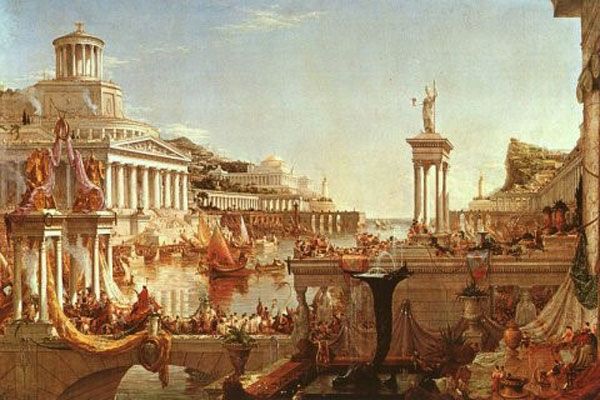
The Consummation of Empire
The Consummation of Empire is one of a sequence of five paintings entitled The Course of Empire commissioned by Cole's patron Luman Reed, created between 1833 and 1836. Each painting in the series depicts the same landscape at a different stage of the rise and fall of an imaginary civilization. This, the middle painting in the series, represents the apparent triumph of that civilization, a scene crammed with classical porticos, rotundas and statuary, with a happy, colorful procession of citizens passing over the bridge in the centre. A statue of Minerva, goddess of wisdom, stands to the right, but seems to be ignored by the hordes beneath.
In fact, the whole series was intended to serve as a warning about the over-weaning ambitions of Empire. Even this painting, which seems to depict that empire at the height of its power, anticipates its demise in the representation of a militaristic ruler carried aloft by the citizens. Later paintings in the sequence show the ruin of the city, and its eventual reclamation by nature, which in this image seems entirely subdued (as represented by the potted plant in the foreground). Anxious to create an epic series of paintings, and inspired by the Neoclassical masterpieces he had seen firsthand during his travels in Europe in 1829-32, Cole nonetheless showed his unique ability through The Course of Empire to capture the American spirit in his work. These paintings sound a note of both triumph - America had recently liberated itself from the British Empire - and caution: that the new state should not fall into the same traps as its European predecessors. More than that, the series seems to express Cole's anxiety about the encroaching threat of industry and urban expansion to the American landscape.
The art historian Earl A. Powell sums up the cultural significance of Cole's series in stating that "[i]n its totality, The Course of Empire represents a truly heroic moment both in Cole's career and in the history of American painting. It was a paradigm of the Romantic spirit - melancholy, grand in conceptual scope, and didactic and moralizing - and it succeeded in delighting its audience." The Course of Empire shows an artist at the height of his powers, whose grand scope summed up the spirit of a nation.
Oil on canvas - The New-York Historical Society
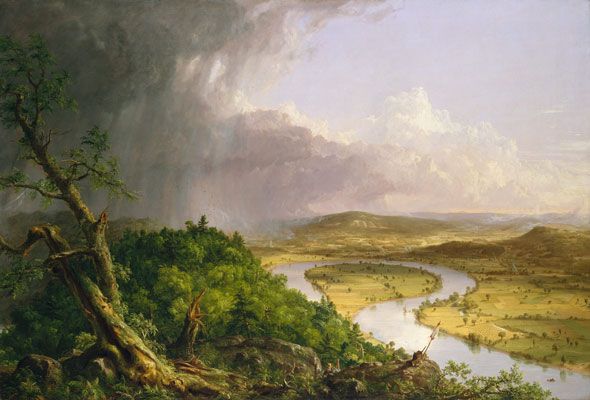
View from Mount Holyoke, Northampton, Massachusetts, after a Thunderstorm
Usually referred to as The Oxbow, this painting shows two very different aspects of the American landscape. To the left of the canvas, dense grey clouds hang over a forest of green trees; to the right, the Connecticut River meanders gently through cultivated fields under a blue sky.
A key painting in Cole's oeuvre, and arguably his best-known work, The Oxbow was created at a time when Cole was largely occupied with his Course of Empire series; his patron Luman Reed had advised him to take a break from that series, as Cole seemed to be showing signs of depression, and to return to the genre of Romantic landscape painting which he loved most of all. Whereas The Course of Empire stands as a stark warning on the fate of civilization, this painting presents a more complex, though still polemical, statement on the potential direction of American society. The uncultivated landscape to the left is at once threatening and enticing, while the cultivated land to the right presents an equivocal image of security, complicated by the presence of scar-lines in the forest on the far hills: signs of the aggressive over-husbandry of the land. Debate exists as to whether a written message can be made out in these marks, with some scholars believing that the lines were intended to spell out the word "Noah" in Hebrew, and would, from the aerial perspective of God, read "Shaddai" or "The Almighty". If that reading is accepted, then the landscape - which, after all, shows a floodplain - stands for the hubris of human society awaiting the cleansing force of divine judgement.
Cole personalized the work by depicting himself at the center of the canvas. Gazing back at the viewer from between two crags, the minute figure of the artist preserves the landscape on his canvas before it is lost, and, perhaps, invites our own judgement on the scene. This personal element reflects Cole's feeling of emotional connection to the work, which now stands as one of the most quintessential examples of mid-19th-century North American landscape painting.
Oil on canvas - The Metropolitan Museum of Art, New York
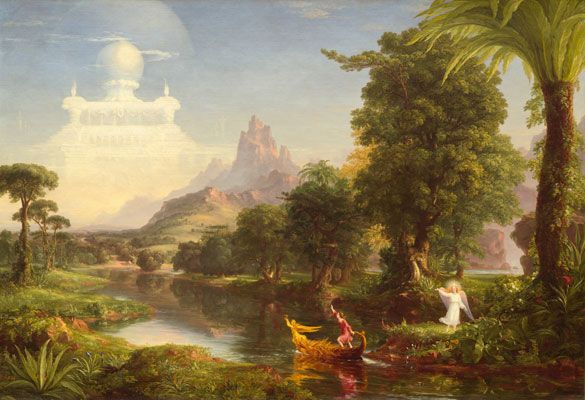
The Voyage of Life: Youth
This work shows a young man rowing a boat down a tree-lined river, towards a ghostly white palace in the sky; on the shore to the left, a guardian angel watches over him, offering him protection on his journey. This is the second in a series of four paintings completed by Cole during 1842 depicting the various stage of man's allegorical journey through life. The other three represent childhood, manhood and old age, with compositional elements and motifs such as the boat, the river, and the angel recurring throughout. The four stages of human life are reflected in the passage of the seasons across the paintings, nature serving as a mirror for man's emotional condition, in quintessential Romantic style.
The Voyage of Life was commissioned by the banker Samuel Ward, and was meant to remind the viewer of the course that must be steered to secure a resting place in eternity. In so doing, these works tap into the cultural mood in America during the 1840s, when a period of intense religious revivalism was underway. At the same time, the 'voyage of life' may be read as an allegory for the progress of American civilization, which was, at this time, in a promising but uncertain stage of its growth. The compositional style exemplifies Cole's approach in combining rugged, American-style landscapes with motifs and techniques borrowed from European landscape painting in both the Neoclassical and Romantic styles.
So popular were the Voyage of Life paintings that they became a source of dispute between Cole, who wanted to keep them on public display, and his patron Samuel Ward, who wanted to keep them for his own private collection, even refusing to sell the paintings back to the artist. In the end, Cole created a second version of the series while visiting Europe in 1842. On a personal note, he had converted to the Episcopal Church in 1941, and these paintings are the best example of the religiously allegorical work which he produced during the last years of his life. Their place and significance within his oeuvre was summed up by William Cullen Bryant during his speech at Cole's funeral, when he described them as "of simpler and less elaborate design than The Course of Empire, but more purely imaginative. The conception of the series is a perfect poem."
Oil on canvas - The Munson-Williams-Proctor Institute, Utica, New York
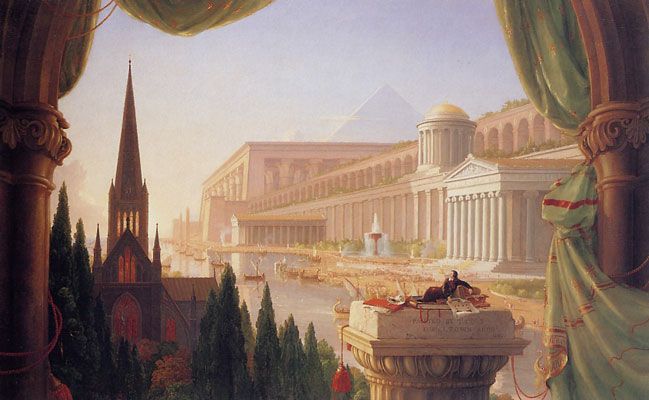
The Architect's Dream
As its title might suggest, the focal point of this painting is the young architect resting on a pile of books in the foreground, atop a classical column. Carved in the column is the dedication "Painted by T. Cole, For I. Town Arch, 1840", indicating the work's creation for the prominent American architect and engineer Ithiel Town. The rest of the canvas is filled with grand architectural monuments, including a vast Greco-Roman portico, a pyramid shrouded in mist in the background, and a medieval cathedral to the left.
This work represents something of a stylistic departure for Cole, in that the natural landscape is not the primary focus. Offering instead a celebration of the history of architecture, Cole presents the young protagonist - presumably based on Town - admiring the great works of the past, implicitly suggesting that the American state, with the help of pioneers such as Town, might inherit and build on the cultural traditions which those works represent. Discussing this aspect of the painting the art historian Matthew Baigell states that "the architect, like the artist, fulfilled his function in society by calling to mind the highest achievements of the past as a way to guide society through the present and into the future. Such a point of view suggests a specific interpretation of the concept of Manifest Destiny - that America might become the new Rome, an improved version of European civilization, rather than a promised land for the chosen people, a new civilization separate and distinct from Europe."
This painting also reflects Cole's own interest in, and occasional practice of, architecture: in 1938 he entered a competition to design the Ohio Statehouse in Columbus, and he produced similar sketches and plans throughout his life. In this sense, the work, like the early portraits which Cole also composed, represents an element of his creative practice which is occasionally forgotten because of the central importance granted to his landscape works.
Oil on canvas - Toledo Museum of Art, Toledo, Ohio
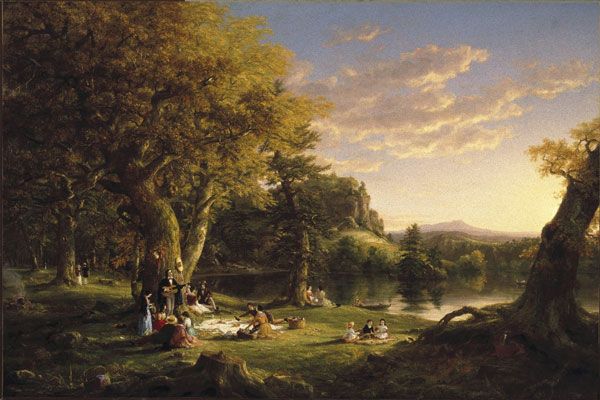
The Pic-Nic
This painting depicts an idyllic scene of outdoor leisure activity, set amongst a glade of trees. To the left, a group of figures sits listening a man playing a guitar. Other, smaller clusters of people seem to have broken off from the central group, and sit on blankets eating and talking. On the lake in the background, a boat is rowed to the shore.
Painted during the last years of the artist's life, this work is one of several created by Cole which present a very different aspect of the American landscape to the desolate wildernesses explored earlier in his career: the wild landscape has been tamed, converted into a picnic site. In one sense, this seems to imply an earnest celebration of the harmonious interaction of human activity and the natural environment; the scene has something of the quality of the Arcadian landscapes depicted in 16th-century Neoclassical painting. At the same time, features such as the hacked-off tree-stump in the foreground suggest a more ironic or resigned attitude to the presence of humankind amongst the wilderness. Certainly, the notion of the Sublime is no longer conveyed, and the work has a more composed, narrative quality than Cole's earlier landscape works.
As a man who felt that "art, in its true sense, is, in fact, man's lowly imitation of the creative power of the Almighty," Cole must have struggled to come to terms with the progress of American society responsible for this kind of order. Indeed, it may have been his sense of the inevitable loss of his beloved wilderness that drew him deeper into his faith in the years before his death.
Oil on canvas - The Brooklyn Museum, Brooklyn, New York
Biography of Thomas Cole
Childhood and Education
Raised in Bolton-le-Moors, Thomas was the only boy amongst the eight children born to parents Mary and James Cole. His father was a woolen manufacturer who often moved the family around during Thomas's childhood, in search of better employment. This peripatetic lifestyle provided various opportunities for the young artist, including an apprenticeship in a printshop in Chorley at the age of fourteen, where he learned how to engrave designs for calico fabrics, and a period of work as an engraver in Liverpool during 1817. Cole developed a love of nature in his youth, and would often take walks with his sister Sarah to admire the landscapes of the north of England.
Early Training
Cole developed an early interest in North America through his reading, which would serve him well when the family relocated there in 1818. Still a teenager, Thomas initially remained in Philadelphia while the family moved on to Ohio; it was in Philadelphia that, in addition to working as a textile designer, he received an early commission to engrave illustrations for a new edition of the seventeenth-century puritan John Bunyan's book Holy War (1682). After a brief trip to the West Indies in 1819, Cole moved to Ohio to be near his family, and to help with the wallpaper business which his father had established. He studied painting for the first time, and was commissioned to create various portraits and landscapes.
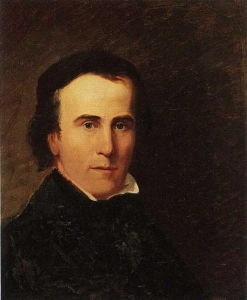
In 1823, Cole returned to Philadelphia, attending classes at the Pennsylvania Academy of the Fine Arts. Two years later, ready to start a formal artistic career, he moved to New York; once he had settled in the city, he began to take trips along the Hudson River Valley to paint the American wilderness. The young artist felt an immediate sense of communion with the landscape of the area, which would remain with him throughout his life. The work which he created from this point onwards became the touchstone for the movement in Romantic landscape painting known as the Hudson River School. His own aims for that work are summed up in a poem from 1825, "The Wild":
Friends of my heart, lovers of nature's works,
Let me transport you to those wild, blue mountains
That rear their summits near the Hudson's wave [...]
He hoped that his depictions of the "blue mountains" of the Catskills might grant his viewers "a sweet foretaste of heaven". But Cole was under no illusions as to threats facing this heavenly landscape: even on his first trips up the Hudson, he would have encountered signs of industry - sawmills, tanneries, burned-over fields - amongst the beauty.
Mature Period
Cole's career received a major boost in 1825 when he sold paintings to two of the most prominent artists of the day, Asher Brown Durand and John Trumbull, and to the influential writer and historian William Dunlap. The following year, Cole was elected to the National Academy of Design, where he often exhibited.
Like all white American artists of the period, Cole's cultural background was European, and he felt it necessary to study the great masters of the Classical and Renaissance traditions to perfect his craft. So, in the summer of 1829, he set off on an extended tour of Europe, making a trip to the Niagara Falls just before leaving. As the artist put it, "I cannot think of going to Europe without having seen them. I wish to take 'a last lingering look' at our wild scenery. I shall endeavor to impress its features so strongly on my mind that in the midst of the fine scenery of other countries their grand and beautiful peculiarities shall not be erased." By the time of his trip, Cole's reputation as a landscape painter was already firmly established in his adopted country, to the extent that his friend, William Cullen Bryant, wrote a poem in honor of him just before his departure, entitled "To Cole, The Painter, Departing for Europe". In it, the author begs the artist not to forget the beauty of the New World amongst the wonders of European art history.
Cole learned much from his European visit, and was able to meet the English Romantic landscape painters John Constable and J M. W. Turner, as well as the portraitist Thomas Lawrence; the art historian Matthew Baigell suggests that Turner's cityscapes subsequently influenced the composition of Cole's Course of Empire series. He also showed his work in various exhibitions while abroad. Notably, while he was considered a progressive figure in America, he was reluctant to embrace some of the more radical stylistic developments evident in his British compatriots' work, in particular that of Turner, whom he felt focused too much attention on impressions of color and light. It was his time in Italy that Cole enjoyed most, stating: "I am not surprised that the Italian masters have painted so admirably as they have: Nature in celestial attire was their teacher."
Cole's return from Europe in November 1832 heralded the start of an important phase of development in his artistic career and in his personal life. In 1833, he met his future patron Luman Reed, for whom he began work on an iconic series of paintings entitled The Course of the Empire (1836). The same year, he married Maria Bartow, the niece of a farm-proprietor from whom Cole was renting a studio in Catskill, New York while he worked on the series. The couple decided to move permanently to Catskill, whose surrounding landscapes were a rich source of inspiration for Cole. It was there, in 1835, that he wrote his influential "Essay on American Scenery", which considers the encroaching threat of industrial development to the natural world: "there are those who regret that with the improvements of cultivation the sublimity of the wilderness should pass away: for those scenes of solitude from which the hand of nature has been lifted, affect the mind with a more deep toned emotion than aught which the hand of man has touched."
Late Period
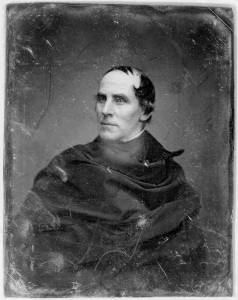
The later years of Thomas Cole's career were ones of reflection and frequent sadness. He was deeply troubled by the onward march of urbanization and industrialization that seemed to threaten the American wilderness; he is said to have despised cities, finding, as Matthew Baigell puts it, "a presentiment of evil in them". Cole's paintings, meanwhile, still depicting the landscape, increasingly seemed to become vehicles for him to address issues such as the passage of time and history, as in his Voyage of Life (1842) series.
Cole was also suffering from a period of ill health, and in the summer of 1841, he decided to travel once more to Europe. Upon his return to New York a year later, he joined the Episcopal Church, and from this point onwards religion would play an increasingly central role in his life. Of the influence of spirituality on art he stated: "Art, in its true sense, is, in fact, man's lowly imitation of the creative power of the Almighty." In 1844, he agreed to take Frederic Edwin Church on as a pupil. This was a fortuitous decision, as Cole would greatly influence the young artist's work, through which the legacy of the Hudson River School, and of Cole's painting in particular, was ensured.
During the summer of 1847, perhaps longing once more for a glimpse of untainted nature, Cole traveled again to the Niagara Falls. This would prove to be his last major expedition, as he died in February the following year at the age of forty-seven. Summing up the power of Cole's work, his friend the author William Cullen Bryant stated in a eulogy delivered at the artist's funeral that "[t]he paintings of Cole are of that nature that it hardly transcends the proper use of language to call them acts of religion."
The Legacy of Thomas Cole
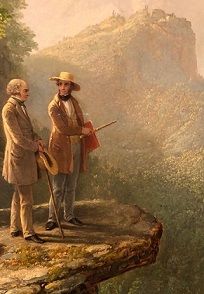
While Romantic landscape painting was a firmly-established tradition in Europe by the early 19th century, Thomas Cole was the first artist to forge a version of that style centered on, and inspired by, the North-American landscape. In so doing, he effectively laid the foundations for the entire style of Romantic painting in North America. He is also considered the father of the Hudson River School, despite never specifically aligning himself with that or any other group. Cole's legacy is evident in the work of future American artists who advanced the Hudson River style, including his student Frederic Edwin Church, Albert Bierstadt, Jasper Cropsey, Asher B. Durand, George Inness, John Kensett, and Thomas Moran.
Speaking more broadly, a whole sweep of 20th-century North-American art, from Precisionism to Land Art, might be seen to have inherited something of the grand scale and ambition of Cole's work. In this sense, his paintings capture not only the character of American culture during the mid-19th century, but perhaps something more enduring about the open and expansive quality of that culture.
Influences and Connections

-
![Claude Lorrain]() Claude Lorrain
Claude Lorrain -
![J.M.W. Turner]() J.M.W. Turner
J.M.W. Turner - Gaspard Dughet
- Salvator Rosa
- Thomas Lawrence
![Henry Wadsworth Longfellow]() Henry Wadsworth Longfellow
Henry Wadsworth Longfellow- William Cullen Bryant
- James Fenimore Cooper
- William Gilpin
-
![Romanticism]() Romanticism
Romanticism -
![Neoclassicism]() Neoclassicism
Neoclassicism -
![Düsseldorf School]() Düsseldorf School
Düsseldorf School - European Landscape Painting
-
![Albert Bierstadt]() Albert Bierstadt
Albert Bierstadt -
![George Inness]() George Inness
George Inness ![Asher B Durand]() Asher B Durand
Asher B Durand- Frederick Church
- Jasper Cropsey
- William Cullen Bryant
- William Gilpin
- Robert Gilmor
- Louis Legrand Noble
-
![The Hudson River School]() The Hudson River School
The Hudson River School -
![Realism]() Realism
Realism -
![Romanticism]() Romanticism
Romanticism - European Landscape Painting
